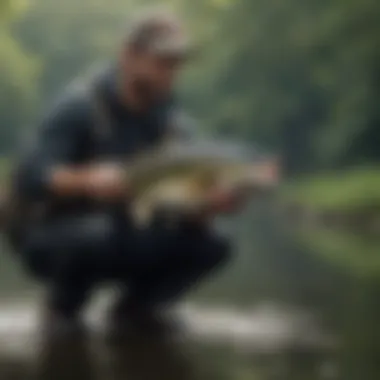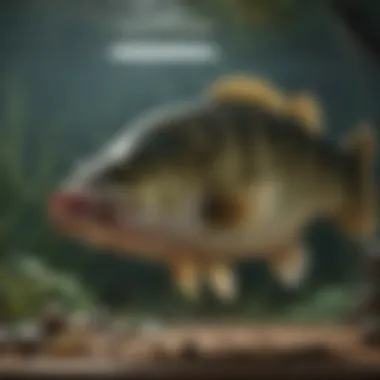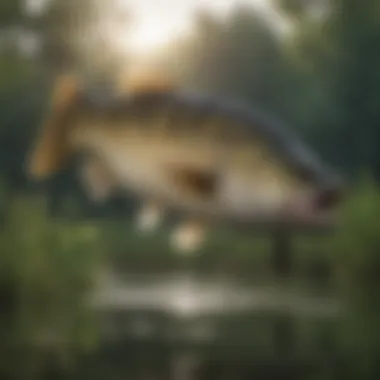Mastering the Art of Catching Largemouth Bass: Advanced Techniques Revealed


Honing Your Skills in Largemouth Bass Fishing
Understanding Largemouth Bass Behavior
In the realm of bass fishing, understanding largemouth bass behavior is like decoding a complex puzzle that unlocks the key to successful angling. A profound grasp of their behavior is not merely a bonus but a prerequisite for those aspiring to elevate their fishing game. By scrutinizing their habitat preferences and feeding patterns, anglers gain valuable insights into the elusive nature of these majestic creatures. This article intricately examines these aspects, shedding light on the intricate balance of factors that influence largemouth bass behavior.
Habitat Preferences of Largemouth Bass
Shallow vs. Deep Water Preferences
When delving into the habitat preferences of largemouth bass, the dichotomy between shallow and deep waters emerges as a critical focal point. The choice between these two distinct environments is not arbitrary but rooted in the evolutionary tendencies of the bass species. Shallow waters, with their proximity to abundant food sources and optimal temperature variations, offer an attractive option for bass seeking nourishment and shelter. Conversely, deep waters provide a sanctuary during harsh conditions and serve as strategic hunting grounds for ambush predators. Understanding this preference dichotomy is fundamental to predicting bass behavior and honing in on prime fishing locations.
Weed Beds and Structures
Weed beds and underwater structures play a pivotal role in shaping the habitat preferences of largemouth bass. These distinct environments offer bass a haven for concealment, ambush, and spawning activities. The intricate weave of vegetation in weed beds provides cover and a hunting ground for bass, fostering a thriving ecosystem. Similarly, underwater structures like fallen logs, rock formations, and submerged brush create a dynamic landscape that bass navigate with finesse. Recognizing the significance of weed beds and structures equips anglers with the knowledge to target prime fishing spots and entice bass effectively.
Feeding Patterns
Delving into the feeding patterns of largemouth bass unveils a fascinating hierarchy of behaviors that dictate their feeding frenzies. The strategic timing of dawn and dusk feeding windows underscores the circadian rhythm that governs bass activity. These low-light periods offer optimal conditions for bass to capitalize on their predatory instincts and hunt with precision. In contrast, ambush points serve as strategic locations where bass lie in wait, ready to pounce on unsuspecting prey. By understanding these feeding patterns, anglers can tailor their approach and lure selection to maximize their chances of a successful catch.
Dawn and Dusk Feeding
Through the veil of dawn and dusk, largemouth bass exhibit heightened activity levels that set the stage for exhilarating fishing experiences. The subdued lighting during these transitional periods triggers a feeding frenzy among bass, as they prowl the waters in search of prey. Leveraging this diurnal behavior presents anglers with a prime opportunity to capitalize on the bass's voracious appetite and tactical prowess.
Ambush Points


Ambush points serve as strategic bottlenecks where largemouth bass unleash their predatory prowess with surgical precision. These secluded locations, often characterized by submerged structures or abrupt depth changes, provide bass with ideal vantage points for staging surprise attacks. By pinpointing these ambush points, anglers can strategically position their bait and anticipate the calculated strikes of lurking bass. Mastering the art of identifying and exploiting ambush points is pivotal in outwitting these cunning creatures and securing a prized catch.
Choosing the Right Equipment
Rod and Reel Selection
Action and Power Considerations
In the realm of rod and reel selection, one crucial aspect to deliberate on is the action and power of the equipment. The action of a fishing rod refers to its flexibility or stiffness, affecting how it bends when pressure is applied. Power, on the other hand, determines the rod's lifting strength and ability to handle larger fish. For this article, focusing on the right balance of action and power is key to conquering the challenges of catching large, robust largemouth bass effectively. Opting for a rod with moderate to fast action and medium to heavy power is often a prudent choice, providing the versatility needed to navigate different water conditions and tackle various fish sizes.
Line and Lure Recommendations
Amid the myriad choices of fishing lines and lures available, understanding the significance of selecting the appropriate ones is imperative for a successful bass-catching venture. The fishing line serves as a direct connection between the angler and the fish, influencing sensitivity, strength, and visibility. Similarly, lures mimic natural prey to entice bass, requiring careful consideration of their design, color, and movement. Finding a balance between these elements is crucial in this article, ensuring your equipment complements your angling techniques seamlessly. Opting for a braided or fluorocarbon line with a suitable lure that matches the bass' foraging behavior can amplify your chances of landing that prized catch.
Essential Tackle
Beyond the rod and reel, having the right tackle is fundamental in enhancing your fishing experience and increasing your catch rate. The choices of hooks, weights, swivels, baits, and lures can make a significant difference in enticing and hooking largemouth bass efficiently.
Hooks, Weights, and Swivels
Exploring the realm of hooks, weights, and swivels unveils a world of tactical advantages for anglers targeting largemouth bass. The type of hook used can affect hook-setting efficiency, while the appropriate weight selection is crucial for reaching different depths swiftly. Swivels play a crucial role in minimizing line twists and enhancing bait presentation. For this article, emphasizing the importance of selecting the right hooks, weights, and swivels cannot be overstated to maximize your bass-catching potential.
Sensible Baits and Lures
The selection of baits and lures is a strategic art form that can make or break your fishing excursion. Sensible choices regarding the color, size, and action of the bait can heavily influence bass behavior and increase your success rate. Opting for natural-looking baits or realistic, action-packed lures tailored to largemouth bass tendencies is crucial. This article delves into the intricacies of selecting baits and lures that resonate with bass feeding patterns, ensuring a rewarding fishing experience and elevating your angling skills to new heights.
Mastering Casting Techniques


Mastering Casting Techniques plays a pivotal role in the art of catching largemouth bass. This section focuses on the intricate skill set required to effectively target and lure in this prized fish species. Understanding the nuances of casting techniques can significantly enhance a angler's success rate and overall fishing experience.
Precision Casting
Precision Casting encompasses a range of specialized techniques essential for enticing and catching largemouth bass with precision. In this article, we delve into the details of two key components: Pitching and Flipping Techniques, and Skipping Baits with Accuracy.
Pitching and Flipping Techniques
Pitching and Flipping Techniques involve delicate maneuvers using bait or lures to precisely place them in targeted areas where bass are known to hide or feed. These techniques require finesse and accuracy in presentation, crucial for triggering strikes from discerning bass. The advantage of Pitching and Flipping lies in their ability to access tight or cover-laden spots often inaccessible by traditional casting methods, increasing the chances of a successful catch.
Skipping Baits with Accuracy
Skipping Baits with Accuracy is a technique employed to skip or slide a bait across the water surface, mimicking natural movements to attract bass. This method is particularly beneficial in enticing bass in shallow or clear waters where a subtle and precise approach is essential. The unique feature of Skipping Baits with Accuracy lies in its ability to mimic fleeing prey or create sudden movements that entice bass to strike. However, this technique requires practice to master due to the need for consistent and precise control over the bait's movements.
Working the Retrieve
Working the Retrieve explores the techniques involved in manipulating bait or lures during the retrieval process. This section emphasizes the importance of control and finesse in inducing strikes from largemouth bass.
Slow and Steady Approach
The Slow and Steady Approach involves a gradual and controlled retrieval of bait, maintaining a consistent pace to entice bass without startling them. This method is effective in enticing cautious or inactive bass by presenting a natural and leisurely movement that appears enticing to the fish. The Slow and Steady Approach's advantage lies in its ability to trigger strikes from bass observing and assessing the bait's movements before committing to a strike.
Jerkbaits and Crankbaits Techniques
Jerkbaits and Crankbaits Techniques revolve around using twitching or jerking motions during the retrieval process to simulate injured or fleeing prey. These techniques aim to provoke aggressive strikes from bass by creating erratic movements that trigger their predatory instincts. The unique feature of Jerkbaits and Crankbaits Techniques lies in their versatility in imitating various types of prey species and their effectiveness in eliciting reaction strikes from opportunistic bass. However, mastering these techniques requires practice to achieve the desired erratic yet controlled movement essential for enticing bass.
Effective Bait Selection


Effective bait selection is a crucial aspect in the art of catching largemouth bass. In this comprehensive guide, the focus is on choosing the right bait to enhance the chances of a successful fishing expedition. Understanding the preferences of largemouth bass and their feeding patterns is vital in selecting the most effective bait. By mastering the art of bait selection, anglers can significantly improve their bass-catching skills. ## Live Bait Options
Leveraging Shiners and Minnows
When it comes to live bait options, leveraging shiners and minnows is a popular choice among anglers aiming to lure largemouth bass effectively. The key characteristic of shiners and minnows lies in their natural movement, mimicking the prey of bass and increasing the chances of a successful catch. Anglers favor shiners and minnows for their lifelike appearance and ability to attract bass in various water conditions. However, their disadvantage lies in being delicate and requiring proper handling to maintain their effectiveness. ### Nightcrawlers and Crawfish Exploring live bait options further, nightcrawlers and crawfish serve as effective choices for targeting largemouth bass. The key characteristic of nightcrawlers and crawfish is their availability and affordability, making them accessible options for anglers of all levels. Nightcrawlers and crawfish offer a natural presentation to bass, enticing them with their scent and movement. However, their disadvantage includes being prone to snags and requiring careful presentation to prevent tangling. ## Artificial Lures
Topwater and Surface Lures
Artificial lures, such as topwater and surface lures, play a significant role in enticing largemouth bass. The key characteristic of topwater and surface lures is their ability to create commotion and ripples on the water's surface, resembling distressed prey and attracting bass. Anglers opt for these lures for their versatility and effectiveness in different water conditions. However, their disadvantage lies in being more visible to bass, requiring strategic placement and techniques for a successful catch. ### Plastic Worms and Jigs Delving into another artificial lure option, plastic worms and jigs offer anglers a versatile approach to targeting largemouth bass. The key characteristic of plastic worms and jigs is their lifelike appearance and texture, mimicking natural prey and enticing bass to strike. Anglers appreciate these lures for their durability and customization options, allowing for tailored presentations to suit varying bass behavior. However, their disadvantage involves the need for specific retrieval techniques and adjustments based on water clarity and temperature for optimal results.
Strategies for Targeting Lunker Bass
In the realm of largemouth bass fishing, mastering strategies for targeting lunker bass holds paramount importance. These strategies serve as the cornerstone for anglers seeking to hook trophy-sized bass successfully. By understanding the behavior and preferences of lunker bass, anglers can significantly improve their chances of a bountiful catch. Targeting lunker bass requires meticulous planning, adept execution of techniques, and patience, making it a challenging yet rewarding aspect of bass fishing.
Big Bass Hotspots
Focusing on Structure
When delving into the realm of targeting lunker bass, focusing on structure plays a pivotal role. Structures such as submerged trees, rocky outcrops, and underwater vegetation serve as prime hiding spots for big bass. The complexity and intricacy of structure provide a favorable environment for lunker bass to thrive, making them ideal hotspots for anglers seeking trophy catches. Understanding how to identify and navigate these structures with finesse is essential for targeting lunker bass effectively.
Deep Water Tactics
Another crucial element in targeting lunker bass is the utilization of deep water tactics. Deep waters offer a sanctuary for large bass, providing cooler temperatures and ample food sources. By delving into the depths where lunker bass lurk, anglers can tap into a treasure trove of bass population that may elude those fishing in shallower waters. Employing deep water tactics involves precision casting, a deep understanding of underwater topography, and patience to entice lunker bass inhabiting these depths.
Night Fishing Techniques
Utilizing Nocturnal Feeding Behavior
Exploring the nocturnal realm of bass fishing entails harnessing the nocturnal feeding behavior of lunker bass. Under the cover of darkness, bass exhibit heightened feeding activity, presenting a favorable opportunity for anglers to target trophy-sized bass. By capitalizing on the natural instincts of bass during night hours, anglers can unlock the potential for landing impressive catches.
Lure Selection for Darkness
Selecting the right lures for night fishing is crucial for success in targeting lunker bass. Dark-colored lures or those with rattling features appeal to the heightened sensory perception of bass during low light conditions. The choice of lures designed specifically for night fishing enhances visibility and attraction, increasing the chances of enticing lunker bass to strike. Tailoring lure selection to suit the darkness of the night can significantly elevate an angler's success rate in catching trophy bass.



